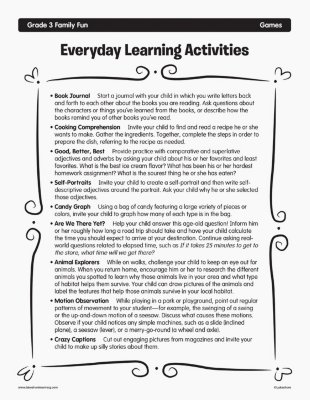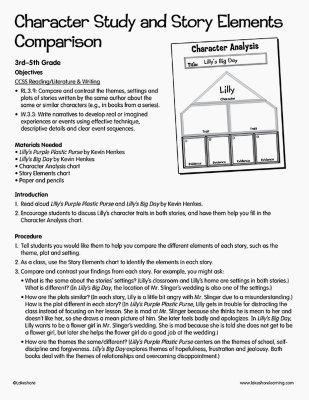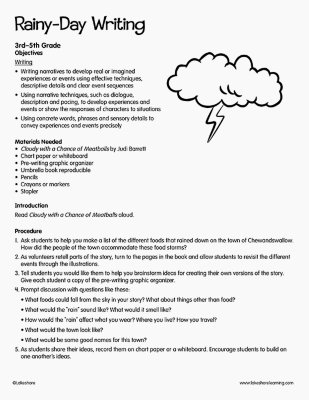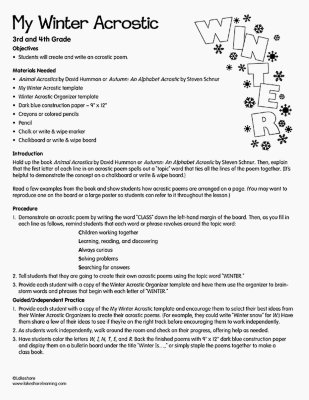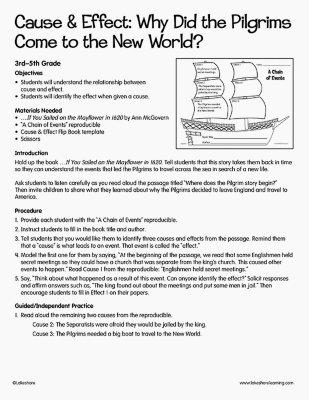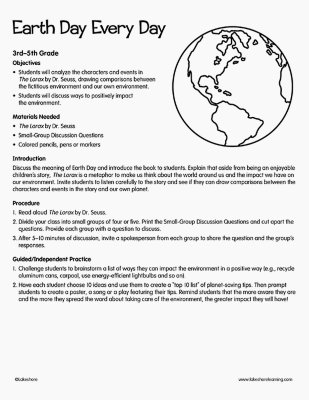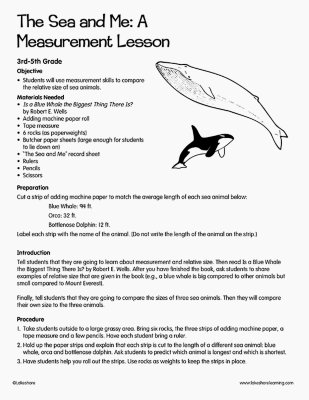Narrow by Grade
- Infant (2)
- Toddler (5)
- Preschool (0)
- Pre-K (13)
- Kindergarten (11)
- 1st (11)
- 2nd (6)
- 3rd (8)
- 4th (9)
- 5th (5)
- 6th & Up (0)
Grade 3rd
Narrow by Age
- 0-18m (0)
- 18-36m (0)
- 3 yrs. (0)
- 4 yrs. (0)
- 5 yrs. (0)
- 6 yrs. (0)
- 7 yrs. (0)
- 8 yrs. (8)
- 9 yrs. (5)
- 10 yrs. (3)
- 11 yrs. & Up (0)
Age
8 results for "books"
Filters
Clear All
Everyday Learning Activities
3rd Grade
Book Journal Start a journal with your child in which you write letters back and forth to each other about the books you are reading. Ask questions about the characters or things you’ve learned from the books, or describe how the books remind you of other books you’ve read.
View Lesson PlanCharacter Study and Story Elements Comparison
3rd Grade - 4th Grade
Objectives CCSS Reading/Literature & Writing RL.3.9: Compare and contrast the themes, settings and plots of stories written by the same author about the same or similar characters (e.g., in books from a series). W.3.3: Write narratives to develop real or imagined experiences or events using effective technique, descriptive details and clear event sequences. Materials Needed Lilly’s Purple Plastic Purse by Kevin Henkes Lilly’s Big Day by Kevin Henkes Character Analysis chart Story Elements chart Paper and pencils Introduction Read aloud Lilly’s Purple Plastic Purse and Lilly’s Big Day by Kevin Henkes. Encourage students to discuss Lilly’s character traits in both stories, and have them help you fill in the Character Analysis chart.
View Lesson PlanCause and Effect
3rd Grade - 4th Grade
Objective CCSS Reading: Informational Text RI.3.3: Describe the relationship between a series of historical events, scientific ideas or concepts, or steps in technical procedures in a text, using language that pertains to time, sequence, and cause/effect. Materials Needed “The Earthquake that Changed Earth” nonfiction reading selection “The Earthquake that Changed Earth” graphic organizer and sample graphic organizer Cause & Effect Flip Book template Scissors Pencils or markers A copy of any other nonfiction text
View Lesson PlanRainy-Day Writing
3rd Grade - 5th Grade
Objectives Writing Writing narratives to develop real or imagined experiences or events using effective techniques, descriptive details and clear event sequences Using narrative techniques, such as dialogue, description and pacing, to develop experiences and events or show the responses of characters to situations Using concrete words, phrases and sensory details to convey experiences and events precisely Materials Needed Cloudy with a Chance of Meatballs by Judi Barrett Chart paper or whiteboard Pre-writing graphic organizer Umbrella book reproducible Pencils Crayons or markers Stapler Introduction Read Cloudy with a Chance of Meatballs aloud.
View Lesson PlanMy Winter Acrostic
3rd Grade - 5th Grade
Objectives Reading: Literature Reading and comprehending grade-appropriate literature, including stories, dramas, and poetry Writing Writing an acrostic poem Materials Needed Animal Acrostics by David Hummon or Autumn: An Alphabet Acrostic by Steven Schnur My Winter Acrostic template Winter Acrostic Organizer template Dark-blue construction paper - 9" x 12" Crayons or colored pencils Pencil Chalk or write & wipe marker Chalkboard or write & wipe board Introduction Hold up the book Animal Acrostics by David Hummon or Autumn: An Alphabet Acrostic by Steven Schnur. Then explain that the first letter of each line in an acrostic poem spells out a “topic” word that ties all the lines of the poem together. (It’s helpful to demonstrate the concept on a chalkboard or write & wipe board.) Read a few examples from the book and show students how acrostic poems are arranged on a page. (You may want to reproduce one on the board or a large poster so students can refer to it throughout the lesson.)
View Lesson PlanCause & Effect: Why Did the Pilgrims Come to the New World?
3rd Grade
Objectives Students will understand the relationship between cause and effect. Students will identify the effect when given a cause. Materials Needed …If You Sailed on the Mayflower in 1620 by Ann McGovern “A Chain of Events” reproducible Cause & Effect Flip Book template Scissors Introduction Hold up the book …If You Sailed on the Mayflower in 1620. Tell students that this story takes them back in time so they can understand the events that led the Pilgrims to travel across the sea in search of a new life. Ask students to listen carefully as you read aloud the passage titled “Where does the Pilgrim story begin?” Then invite children to share what they learned about why the Pilgrims decided to leave England and travel to America.
View Lesson PlanEarth Day Every Day
3rd Grade - 5th Grade
Objectives Students will analyze the characters and events in The Lorax by Dr. Seuss, drawing comparisons between the fictitious environment and our own environment. Students will discuss ways to positively impact the environment. Materials Needed The Lorax by Dr. Seuss Small-Group Discussion Questions Colored pencils, pens or markers Introduction Discuss the meaning of Earth Day, and introduce the book to students. Explain that aside from being an enjoyable children’s story, The Lorax is a metaphor to make us think about the world around us and the impact we have on our environment. Invite students to listen carefully to the story and see if they can draw comparisons between the characters and events in the story and our own planet.
View Lesson PlanThe Sea and Me: A Measurement Lesson
3rd Grade
Objective Students will use measurement skills to compare the relative size of sea animals. Materials Needed Is a Blue Whale the Biggest Thing There Is? by Robert E. Wells Adding machine paper roll Tape measure 6 rocks (as paperweights) Butcher paper sheets (large enough for students to lie down on) “The Sea and Me” Record Sheet Rulers Pencils Scissors Preparation: Cut a strip of adding machine paper to match the average length of each sea animal below: Blue Whale: 94 ft. Orca: 32 ft. Bottlenose Dolphin: 12 ft. Label each strip with the name of the animal. (Do not write the length of the animal on the strip.) Introduction Tell students that they are going to learn about measurement and relative size. Then read Is a Blue Whale the Biggest Thing There Is? by Robert E. Wells. After you have finished the book, ask students to share examples of relative size that are given in the book (e.g., a blue whale is big compared to other animals but small compared to Mount Everest). Finally, tell students that they are going to compare the sizes of three sea animals. Then they will compare their own size to the three animals.
View Lesson Plan